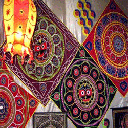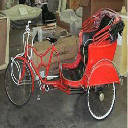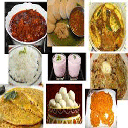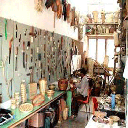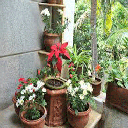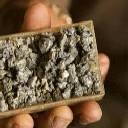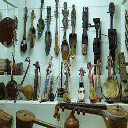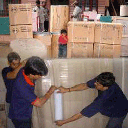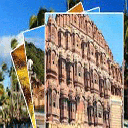Tamil Nadu is located in the Northern hemisphere in the torrid zone between 8 degrees and 13 degrees N. latitude and between 78 degrees and 80 degrees E. longitude. It is bounded by the state of Karnataka and Andhra Pradesh in the north and Kerala in the west. The southern tip is in the Indian Ocean and the long eastern coast is lapped by the Bay of Bengal. Point Calimere forms the easternmost tip and the Mudumalai wildlife sanctuary is the westernmost tip. The northern extreme touches lake Pulicat. The southernmost tip is Cape Comorin or Kanyakumari. Tamil Nadu, the 11th largest state in India has a population over 6 crore and occupies an area of 130,058 sq.km. The union territory of Pondicherry is a tiny pocket within the boundaries of Tamil Nadu near Cuddalore district; Karaikal, a little away from Pondicherry is near Nagapattinam district. The ancient Tamils divided the land into five major physiographic parts as follows: Kurinji- mountainous region, Mullai- forest region,Marudham- the fertile plains, Neidhal- the coastal region and Palai- the arid region. The Western ghats and the Eastern ghats meet in the Nilgris of Tamil Nadu. The hill stations of Tamil Nadu, Ooty, Kodaikanal, Kothagiri and Yercaud are situated in this region. Though the eastern ghats is broken and appears to be a residual mountain, the Western ghats stretches along almost as an unbroken chain except for a 25 km gap at Palakkadu and a still lesser gap in Shencottah. These gaps are the entry points to the state of Kerala. Unlike the Eastern ghats, the Western ghats receive abundant rain and are full of evergreen forests and the valleys of Cumbum and Pollachi besides having picturesque sceneries contain tea, coffee and spice plantations. The upper reaches of the Eastern ghats are called the Shervaroys famous for their fruit gardens and coffee plantations. Yercaud is situated in this region. Tamil Nadu has a rich variety of flora and fauna. Indira Gandhi wildlife sanctuary in Anaimalai and Madhumalai wildlife sanctuary are situated in the Eastern ghats. Elephants, tigers, bisons and a variety of monkeys and deer roam about freely in them. Over 3000 plant species are also found there. The most important of them is the Kurinji plant which blooms once in 12 years. The name Kurinji to the hilly region is derived from this flower. Various medicinal herbs are also found in Palani hills and Courtallam. Palmyrah groves are abundant in Tirunelveli district which is the major source of a plethora of cottage industries. Rubber plantations abound in Kanyakumari district and sandal trees are grown in Javvadu hills of the eastern ghats near Vellore. The rivers of Tamil Nadu are not perennial and one could only see a sandy dry river bed in summer. The Cauvery is the longest and most important river originatiing in Coorg in the state of Karnataka. Its water is utilized for cultivation in the deltaic region of Thanjavur and Nagapattinm districts. The other rivers are the Palar, Pennar, Vaigai, Tamairaparani which are flooded during the rainy season. The only arid region or Palai is found in Tirunelveli district. It is called there by the natives. Tamil Nadu has a long coastal line, about 912 km which is named coromandal coast or cholamandalak karai in the northern half and the southern coast is the pear fisheries coast. Mylapore, Poompuhar, Mamallapuram and Kayalpattinam were the ancient seaports along the coromandal coast. Maritime trade flourished between these ports and the ports of Rome, Greece and the East Indies. Mangrove forests found at Pichavaram near Chidanbaram, Pulicat lake and Vedanthangal are important bird sanctuaries. t was the third largest economy (2007–2008) among all states in India,and also the most industrialised state in India.Tamil Nadu was India's fifth biggest producer of Rice.The Cauvery delta region of the composite Thanjavur district is known as the Rice Bowl of South India. The main vegetables grown are tapioca, tomato, onion, brinjal and drumstick. Tamil Nadu is also a leading state in the production of flowers with the total production of horticultural crops standing at Indian Rupee symbol.svg 99.47 Lakhs during 2003–04. The main flowers grown in Tamil Nadu are Jasmine, Mullai, Chrysanthemum, Marigold and Rose. Paddy fields at Nagercoil The state is the largest producer of bananas,flowers,tapioca, the second largest producer of mango, natural rubber,coconut,groundnut and the third largest producer of coffee, sapota, Tea and Sugarcane. Tamil Nadu's sugarcane yield per hectare is the highest in India. The state has 17,000 hectares of land under oil palm cultivation, the second highest in India.Tamil Nadu is the home to Dr M.S. Swaminathan, known as the "father of the Green Revolution" in India. Tamil is the only official language of Tamil Nadu. English is also in common usage as an official language of India. When India adopted national standards Tamil was the very first language to be recognized as a classical language of India.The Tamil people regard their language a very important part of their cultural identity. Tamil Nadu is the one of the most literate states in India.Tamil Nadu has performed reasonably well in terms of literacy growth during the decade 2001–2011. The state's literacy rate increased from 73.47% in 2001 to 80.3% in 2011 which is above the national average Tamil Nadu has 37 universities, 454 engineering colleges. and 566 arts and science colleges, 34335 elementary schools, 5167 high schools, 5054 higher secondary schools and 5000 hospitals.
Chennai The gateway to South Indian peninsula; also a place of historic importance. It is a pulsating city, ever changing and ever expanding. The city is probably the most peaceful and green metropolis of India. It was once a group of small villages until the appearance of East India Company to set up a new trade centre in the place. This land was known as Fort St. George during British era. The city is connected by four main roads. Georgetown is to the northwest while Egmore, Triplicane and Mylapore are to the south of Chennai. The city is a blend of temples, churches, monuments and several other prime destinations. Its fascinating monuments and churches date back to the Portuguese and British period. The spectacular Marina Beach stretches 13 km along the city’s eastern flank which is a favourite place for the city dwellers and visitors. The Fort St. George is another widely visited spot of the city that depicts colonial influence of British and Portuguese on the city. Major places of worship are Parthasarthi Temple, Kapaleeswarar temple, Wallajah mosque, “Thousand lights†mosque and San Thome Basilica. Chidambaram This sacred temple town is located in Thanjavur district, about 60 km south of Pondicherry. The focal point of the town is the awe inspiring Nataraja Temple, built by the Cholas in the 9th century to honour their patron deity Lord Shiva as Nataraja, the “Lord of Cosmic Danceâ€. The temple has an unusual hut-like sanctum with a gold plated roof, the huge, colonnaded Shivaganga tank and four colourful gopuras. The most interesting is the eastern gopura which features the 108 hand and feet movements of Bhrat Natyam and is considered as a veritable encyclopedia of this classical temple dance. Other areas of interests in the temple complex are the Govindarajaswamy Shrine, housing the reclining Vishnu, the Shivakamasundari Shrine, dedicated Shiva’s consort Parvati and the Subramanyam Shrine in which Murugan (Shiva’s son) is worshipped. The temple observes religious traditions preserved by a group of hereditary priests. Chidambaram’s other claim to fame is the 50 years old Annamalai University, Tamil Nadu’s first residential university, specializing in South Indian studies. Coimbatore Muruga Maruthamalai Temple:Just 12 kms away from Coimbatore railway station is the temple of Muruga Maruthamalai dedicated to Murugan, the son of Lord Shiva. The temple is situated on the Murudamalai Mountain visited by large number of tourists during festivals. It is believed that the presiding deity "Dandayuthapani" had performed several miracles here. Perur Patteeswaraswamy Temple:About 7 kms west of Coimbatore city (near river Noyyal) is the Perur Patteeswaraswamy Temple, built by Karikala Cholan and is dedicated to Lord Shiva. The temple has its significance in earlier days that unfolds the poetic creations of Arunagiri Nather and Kachiappa Munivar. Forest College Museum:The Forest College, situated 3.5 kms from the Coimbatore railway station has one museum of worth a visit. It is one of the oldest colleges of the country. The museum houses the fossils of plants and animals. It has also a rare collection of dead specimen of plants and animals of different variety. The museum has one special advisory counter offering service to promote businesses related to plant husbandry. Khadi Gandhi Gallery:The Khadi Gandhi Gallery came up in the city on 15th of July 1970 by the assistance of the Government of Tamil Nadu. The gallery exhibits pictures of Mahatma Gandhi right from his childhood. Separate cubicles are arranged for each phase in Gandhi' life, which shows all major events that occurred in his life. You can also see rare collections of photographs titled 'Journey through Harijan Life', 'Family', 'Friends', 'Independence Struggle', 'Jail Life' and "Peace Talks'. Gandhi Jayanti is celebrated with grandeur in this gallery and the collector visits the gallery during 'Gandhi Jayanti' and participates in the function followed by bhajans. Government Museum:The Government Museum of Coimbatore was established in the year 1989. The museum is situated in VOC Park Road, which bears the remnants of various tribes of the place. The museum has been divided into 5 sections. The main objects displayed in the museum include fossil remains and age-old tools, the megalithic burial materials, treasure trove materials, ancient coins and decorative artifacts. A separate section for old rocks, minerals and wood fossils and tribal medicinal plants is also there to raise tourist’s interests. Annamalai Wildlife Sanctuary:Annamalai Sanctuary About 90-km from Coimbatore city, is Annamalai wildlife sanctuary, situated at a height of 1,400 meters on the Western Ghats near Pollachi. The total are covered by the sanctuary is 958-sq-kms. The sanctuary also encompasses a National Park with wide species of flora and fauna. The park has recently been renamed as Indira Gandhi wildlife sanctuary. Black Thunder Amusement Park:About 40 km away from the city, on Coimbatore - Ooty main Road lies Black Thunder, a water sports and amusement park widely visited by tourists to have fun and amusements. The park offers exciting moments of adventure and fun while you are with your family and friends. This is the best place for children to experience fun and joy; take a break from your busy life to experience some extraordinary events at Black Thunder. The Siruvani Waterfalls:The Siruvani waterfalls and the dam are located at a distance of 37-km west of Coimbatore. Siruvani water is famed for its taste and purity. The landscapes views of the surroundings of the dam and the falls are very beautiful. Kanchipuram The small temple town of Kanchipuram or kanchi is one of the seven sacred cities of Hindus. Starting from 6th centuries to the 8th centuries the Pallavas constructed several temples here and established universities for higher learning. The town is sacred to both Saivites and Vaisnavites. There are two temples: the temple of Saivites to the north and the temple of Vaisnavites to the southeast. The Varadaraja temple on Gandhi Road is the town’s prime visiting site. The presiding deity in this temple is a form of Vishnu known as Varadaraja. Legends say that it is the site where Brahma performed yagna to invoke the presence of Vishnu. About 14 kms from Mamallapuram is a crocodile breeding centre known as Crocodile Bank. There is also a snake farm which regularly conducts show on how venums are extracted from these snakes. The Anna memorial is the ancestral house of Dr. C.N. Annadurai, the scholar statesman, affectionately called Anna. This memorial is located here and is visited by numerous visitors everyday. Kanyakumari Kumari Amman Temple:Kumari Amman Temple, a popular pilgrimage of Kanyakumari located on the seashore, was built by the Pandya kings in 8th century and extensively renovated by the Chola, Vijayanagar and Nayaka rulers. The temple is dedicated to the virgin Goddess Devi Kanyakumari who is supposed to have done penance here so that she could marry Lord Shiva. The magnificent structure of this temple is reflected in its Navaratri Mandapa which has been beautifully painted and carved. The image of Mahishamardini (Durga killing demon Mahisha) is highly fascinating. Inside the temple there is an 18th century shrine with the foot prints of the goddess Kumari who performed her penance at this spot. Church of Our Lady of Joy:The “Church of Our Lady of Joy†built by St. Francis Xavier is located at the southern edge of the town. The church is believed to have been founded in the year 1540. The sandy beaches and the multi coloured granite rocks are among other attractions here. The Church of St. Xavier enjoys a great fame and is visited by large numbers of devotes during the annual festival celebrated in between November and December which lasts for 10 days. Thiruvalluvar Statue:Near the Vivekananda Memorial, there is an imposing 40-m high statue of Tiruvalluvar, the 1st century BC Tamil poet, who wrote the epic Tirukural, often considered as one of the greatest classics of Tamil literature. Kamarajar Manimandapam:Another remarkable monument of this district is Kamarajar Manimandapam which is dedicated to Late Sri Kamarajar, a freedom fighter and former Chief Minister of Tamil Nadu, also President of Indian National Congress before independence. He was known by the name of Black Gandhi among the masses and king maker during congress regime. This building, where his ashes were kept for general mass to pay homage before immersion into the sea is today widely visited by people of the state to show their gratitude. Udayagiri Fort:Udayagiri Fort is a worth visiting site in Kanyakumari owing to its magnificent structure and quite surrounding atmosphere. The fort was rebuilt in the reign of Marthandavarma, the Venad King, during 1741-44. In the early days, the fort was of strategic importance. Prisoners captured in the campaign against Tippu were confined in this fort for sometime. Recently, the district administration has established Biodiversity Park here in collaboration with the forest department. Tourists can see deer, ducks, fountains, birds and over 100 varieties of trees inside the fort. Mathur Hanging Bridge:The Mathur Hanging Bridge is the tallest as well as the longest trough bridge in Asia, with a height of 115 feet and a length of one kilometer. Completed in 1966, this bridge has become a place of attraction for hundreds of tourists visiting every day. This is situated in Mathur, hamlet of Aruvikkarai revenue village in Thiruvattar Panchayat Union. The Kanyakumari District Administration has recently put up a staircase from top to the bottom of the bridge and has also built a children's park and bathing platforms over here to attract more tourists. Padmanabhapuram Palace: is an ancient town and also one of the four municipalities in the district situated just 55 Km. south of Trivandrum, about two km. east of Thuckalay and 35 km. from Kanyakumari on the Trivandrum-Cape Comerin road. This town has a magnificent fort spread over an area of 187 acres. The palace is present at the very centre of this Fort, amidst hills, dales and rivers. The palace is under the control of a Curator of the Archaeological Department of Kerala Government. The prime attractions of this palace are the Entrance Hall, Uppirika Malika, and the Navarathri Mandapa. Vivekananda Rock Memorial:Just off the coast, on a small rocky island lies Vivekananda Memorial, a place visited by large number of tourists. This is the spot where Swami Vivekananda, the great philosopher of India meditated before attending the World Religious Conference in Chicago in 1893. The Memorial commemorates the visit of Swami Vivekananda to “Shripada Parai†during 24th, 25th and 26th December 1892 for deep meditation and enlightenment. Mahatma Gandhi Memorial:The Gandhi Memorial located near the Kumari Amman Temple, is the place where the ashes of Mahatma Gandhi, the Father of Nation were kept before immersion. The building is designed in such a way that every year on October 2nd (Gandhiji’s birth day), at mid day the sun rays directly fall on the exact spot where his ashes were placed. This beautiful monument was completed in 1956. Its central shape is 79 feet high representing the age of the Mahatma. The memorial was transferred to the administrative control of the Public (Information and Public Relations) Department from Public Works Department of Government of Tamil Nadu in the year 1978. Muttom beach: is one of the widely visited beaches of Tamil Nadu, located about 16 kms from Nagercoil and 32 kms from Kanyakumari. Muttom is famous for its beautiful landscaping and high rocks dipping into the sea at the beach-side. The sun set view point at Muttom is one of the most Panoramic view points in the district. One more attraction of Muttom is the century old light-house built by the British. However, this beach has always been unsafe for the tourists since the rocks on which tourists go to see the sea view are slippery and a number of fatal accidents have occurred over the past few years. Sanguthurai Beach:One of the most beautiful beach resorts of Tamil Nadu is Sanguthurai, about 10 kms from Nagerkoil. Recently, the district administration has sanctioned a project for putting up of a children's park, seating facility, open huts (Kudils) with Terracotta roofs and lighting facility at the beach at a cost of Rs.6.00 lakhs. With the development of these services, the beach has become popular leisure place for local residents. Chothavilai Beach:Located about 10 Kms from Kanyakumari, Chothavilai Beach is one of the best natural beaches of the district. The beach has shallow water and huge sand dunes at the background. The District Administration has taken several steps for the development of this beach by putting up rest shelters, kudils and a view tower over here for the benefit of tourists. The tourists can reach the beach through the newly laid coastal road which is a very beautiful drive along the sea-coast. Tirparappu Water Falls:The water fall at Tirparappu is about 13 km. from Pechiparai dam. The river bed is rocky and about 300 feet in length. The water falls from a height of nearly 50 feet and the water flows for about seven months in a year. On the left bank of the river in between the water falls and the weir, there is a temple dedicated to Lord Siva enclosed by strong fortification. The District Administration has recently constructed a swimming pool here which is very popular among the children. Fountain at Kanyakumari:Kanyakumari is famous for its majestic hills, virgin beaches, pristine rivers and meandering rivulets. Most of the tourists visit this district for seeing Rock memorial and forts. The district administration has established water fountain at the juncture of Kanyakumari and Padmanabhapuram Palace to attract more tourists. Maruthuva Malai or Marunthu Vazhum Malai :is the abode of medicinal herbs forming a part of Western Ghats. It is believed that it is a part of Sanjeevi Mountain that Hanuman carried from Mahendragiri to Sri Lanka for healing the fatal wounds of Lakshman, the brother of Lord Rama. While carrying the huge mountain to the destination, Hanuman dropped a small portion here which now stands 800 feet high. The site is 11 km from Nagerkoil. Kodaikanal About 120 kms North West of Madurai city is kodaikanal, Tamil Nadu’s most popular hill stations. Kodai is situated at a height of about 2,133-m from sea level covering an area of 21.45-sq-km. The hill town is famous for its educational institutions (schools and colleges) of international repute. Kodai as it is popularly called was first discovered by American missionaries in the 1840s. Kodai’s lush green valleys, terraced plantations and a pleasant climate make it a tourists’ paradise. The Berijam Lake (or Kodai Lake), one among the beautiful lakes of South India, spreads over an area of 24 hectares. Beyond the city centre Kodai has a number of beautiful scenic spots viz. Pillar Rocks, Silver Cascade and Green valley View which offer enchanting picnic spots and views of the deep valley. Some 3 kms northeast of the Kodai Lake is the Kurunji Andavar Temple, dedicated to Murugan, Lord Shiva’s son. It is named after the amazing kurunji flowers associated with the God. The Chettiar Park nearby laid out along the hillside, is where kurunji blooms every 12 years. Madurai Sri Meenakshi - Sundareswarar Temple:Sri Meenakshi Temple Madurai is synonymous with the Meenakshi Sundareswarar Temple, dedicated to Lord Shiva, known here as Sundareshvara and his consort Parvati or Meenakshi. The temple was originally built by the Pandyas (7th – 10th centuries) but extensively added by the successive rulers between the 14th and 18th centuries. The temple complex consists of high walled enclosures inside which the sanctums for Meenakshi and Sundareshvara are kept surrounded by other smaller shrines. The most impressive are the 12 gopuras. Their soaring towers rise from solid granite bases and are decorated with figures of deities, mythical animals and flowers, painted in vivid colors. The temple remains open on all days. Non-Hindus are not allowed inside the sanctum. There is also a museum open to the public without any charges. Two festivals viz. Chitirai and Avanimoolam are celebrated here with great enthusiasm. Thirupparankundram Temple:Just 7 kms southwest of Madurai, is a small town known for its sacred granite hill. The site is regarded as one of the six sacred abodes of Murugan, son of Lord Shiva. This is the place where he married to Devyani, daughter of Indra. There is a rock cut temple here built by the Pandya rulers in the 8th century. The temple has been beautifully carved and decorated with mandapas. A 14-day temple festival is held in March/April to commemorate the victory of Murugan over the demon Suran. Kadal Alagar Temple:Towards the south west of Meenakshi temple is the Alagar Temple dedicated to Lord Vishnu. The temple is considered to be one of the 108 sacred Vaishnavite shrines in India. The temple has three superimposed sanctuaries of diminishing size, housing Lord Vishnu. The outer wall has beautiful sculptures and stone carvings. The temple remains open on all days but not allowed to non-Hindus. Alagar Koil:The temple at Alagar Koil, 12 kms north of Madurai is dedicated to Kallalagar, a form of Lord Vishnu, who is known to be Meenakshi’s brother. The main attractions here are Sadhus (Swamiyars), or homeless, casteless holy man passing, mischievous monkeys among the families that bring their small children to have their heads shaved, coated in cooling sandalwood paste, and blessed. This small town is located at the foot of the Alagar Hills. Anglican Cathedral:Towards west of Madurai, is a magnificent Church, designed by Robert Fellowes Chisholm and was consecrated in 1881. This church is a fine example of Neo-Gothic architecture of the British era, a widely visited site in Madurai. Gandhi Museum:Gandhi Museum is one of the distinct places of Madurai retaining the living memorial of the Father of Nation – Mahatma Gandhi. The museum houses some of the rare objects used by Gandhiji, valuable books and manuscripts. Tombs of the Madurai Sultans:Towards the north of Vaigai River are the tombs of the Madurai rulers. The sultans were buried to the north of the city. The complex includes Alaauddin’s Mosque with its flat-roofed prayer hall and the tomb of a local Sufi saint, Bara Mastan Sada built in the 16th century. Thirumalai Nayaka Palace:About 1.5 kms from Meenakshi temple is a grand palace built by Thirumalai Nayaka in 1636. The palace reflects the power and wealth of Nayakas who ruled the city for over centuries. The building with its interesting Islamic influence was partially restored in the 19th century by Lord Napier, Governor of Madras between 1866 and 1872. Mamallapuram The UNESCO World heritage site Mamallapuram (or Mahabalipuram) was once a major port city built in the 7th century by the Pallava king, Narasimha Varman I, also known as Mamalla, “The Great Wrestlerâ€. This spectacular site located on the Bay of Bengal is 58 km South of Chennai. The spectacular shore Temple perched dramatically on a promontory by the sea, has survived the ravages of time and erosion. It was built by Mamalla for Vishnu, while the two Shiva shrines were added by Mamalla’s successor Narasimha Varman II. Mahabalipuram was the second capital of Pallava kings of Kanchipuram. Inland from the shore temple, in the village centre is the celebrated base relief Bhagiratha’s penance, also known as Arjuna’s Penance or the Descent of the Ganges. Nearby are the Panch Pandava Cave temple and Krishna’s Butter Ball, a natural boulder perched precariously on a slope. Towards the south of Bhagiratha’s Penance is the Krishna’s Mandapa, a huge base-lifting showing the god lifting the Mount Govardhana to protect the people from torrential rains. A small archeological museum, with sculptures and fragments excavated from the site, lies to its east. It remains open on all days. Entry to the shore temple is based on tickets. The Tiger’s Cave is about 4 kms away from the town and is a shallow cave framed by a large boulder with heads of yalis (mythical leonine beasts). It was perhaps a stage for outdoor performances. Nilgiri Mudumalai Wildlife Sanctuary:This wildlife sanctuary is located in the district of Nilgiri at a distance of 64 km from Udhagamandalam (Ooty). Mudumalai means Ancient Hill Range separated from Karnataka’s Bandipur National Park by the Moyar River. This sanctuary is a part of Nilgiri Biosphere reserve of the Western Ghats. The total area covered by the sanctuary is about 322 sq km. The Moyar waterfall that is at the lowest point of the sanctuary, offers picturesque beauty to the atmosphere. The Park provides an important refuge for the elephants and bison. You can also see the deciduous forests interspersed with grassland and bamboo brakes. The park remains open on all days. Entry is based on tickets. There are also facilities of jeeps for the tourists to travel the whole site. Rananthapuram This ancient town is associated with the Setupatis, local rulers who rose to prominence in the late 17th century under the Madurai Nayakas. They derived prestige and income by controlling the isthmus that led to Rameshwaram Island. But in 1792 they surrendered to the East India Company. To the west of the present town is the palace complex of the Setupatis. Though little remains, the 17th century Ramalinga Vilas, on the north side of the palace complex, still has well-preserved wall paintings. A small shrine facing north is dedicated to the family goddess of the Setupatis, Rajarajeshvari. It stands immediately south of the Ramalinga Vilas. On the outskirts of the town is the 800 years old Erwadi Dargah, housing the tomb of Ibrahim Syed Aulia, a Muslim saint. It attracts devotees from all over India and even from abroad during its annual festival in December. Rameshwaram Ramanathaswamy Temple:The Ramanathaswamy temple, dedicated to Lord Shiva is situated in the middle of the island. It houses the linga that Lord Rama, the hero of the epic Ramayana, is said to have installed and worshiped after his victory against Ravana in Lanka. Founded by the Chola rulers but expanded extensively during Nayaka period, in the 16th and 18th centuries this massive temple is enclosed within high walls with five gopuras. The most remarkable feature of this temple is the Sokkattan Mandapa which surrounds the core of the temple on four sides in a continuous corridor. The water of the 22 sacred wells in the temple taste differently. Dhanushkodi: named after Rama’s bow is 18 kms from the main temple, has a spectacular beach. From this place you can see a series of boulders known as Adam’s bridge extending far into the horizon. These are believed to have been used by Hanuman who had crossed the sea in search of Devi Sita, Rama’s consort. There is a temple on the shore known as Kodandarama temple, where Ravana’s brother believed to have surrendered before Rama. The temple surprisingly survived a devastating cyclone in 1964. Gandamadana Parvatham:Gandamadana Hill, the highest point of the island houses the foot prints of Lord Rama in a two storeyed mandapa. The site is 3 km away from the Ramanathashwami temple. Erwadi:About 24 kms from Rameshwaram is Erwadi, famous for its tomb of Ibrahim Sahid Aulia. Muslims all over the country visit the place during December every year to participate in the festival and to offer tribute to the great saint. Thanjavur Sri Brihadeshvara Temple:This finest granite structure is now a UNESCO World heritage site. Completed in AD 1010 and dedicated to Lord Shiva, it was built by Rajaraja Chola I as a symbol of the unrivalled power and might of the Cholas. The temple basement is covered with inscriptions that give details of the temple’s administration and revenue, and provide valuable historical information on Chola society and government. The temple is constructed using granite, mostly of large blocks, a rock that is not available in the neighborhood and had therefore to be brought from a distance- itself a colossal task. The plinth of the Central Shrine is 45.72 square m., the shrine proper 30.48 square m. and the vimana 60.96 m. high. On the massive plinth, covered throughout with inscriptions, there are niches on three sides in two rows, containing representations of deities such as Siva, Vishnu and Durga. The entire wall space and ceiling of the passage were originally covered with exquisite paintings; a coat of paintings, executed during the Nayak period in the seventeenth century, now obscures most of them. Schwartz Church:The 18th century Schwartz Church or Christ Church is a legacy of Tanjore’s colonial past, standing to the east of the Shivaganga Tank. This church was constructed by the Danish missionary, Reverend Frederik Christian Schwartz in 1779. When he died, the enlightened Maratha ruler Serfoji II donated a striking marble tablet to the church. This tablet made by John Flaxman has been placed at the western end of the church. It depicts the dying missionary blessing his royal patron, surrounded by ministers and pupils from the school that he established. Shivaganga Fort:The Quadrangular Shivaganga Fort is situated towards the south west of the old city. Built by the Nayaka ruler, Sevappa Nayaka, in the mid-16th century, the battlemented stone structure covers an area of 35 acres surrounded by a part rock-cut moat. The Square Shivaganga Tank in the fort was excavated by Rajaraja I and later renovated to provide drinking water for the City. The fort contains the great Brihadishvara Temple, Schwartz Church, and public amusement park. Royal Palace:This palace was originally built by Nayaka rulers as their royal residence and was further reconstructed by Maratha rulers. A large quadrangular courtyard leads into the palace complex. Outside the palace there is a seven-storeyed observation tower meant for the royal families. The splendid Maratha Durbar Hall, built by Shahji II in 1684 has elaborately decorated pillars, walls and ceilings. The Durbar Hall now houses the Rajaraja Museum and Art Gallery with an impressive collection of bronze and stone idols dating from 7th to 20th centuries. Next to the museum is the Saraswati Mahal Library, constructed by the Maratha rulers. This is one of the most important reference libraries in India. An adjoining museum known as Royal Museum displays personal collection of Serfoji II. Tiruchirapalli Jambukeswara Temple:Dedicated to Lord Shiva, Jambukeshwara temple is situated 2 kms east of Srirangam and 10 kms from Tiruchirapalli. The temple is named after the elephant which is believed to have worshipped Lord Siva here. Installed under an ancient Jambu tree, the lingam is partially submerged by water and meant to represent God incarnate as water. Ranganatha Temple (Srirangam):Srirangam is a small town located 9 kms North of Tiruchirapalli city and is known for its temple dedicated to Lord Vishnu. This is one of the largest temple complexes of Tamil Nadu comprising an area of 148 acres. The Ranganatha temple complex as it exists today has evolved over a period of four centuries. The temple originally constructed in 10th century has undergone extensive reconstructions during the period of Nayaka rulers. The temple complex is dominated by 21 gopuras with walls defining its seven enclosures. The most magnificent part is the spacious Thousand-Columned Mandapa, where images of Ranganatha and his consort are worshiped during festivals. Cathedral of Our Lady of Lourdes:At the base of the Rock Fort is the Teppakulam Tank surrounded by vegetable and flower markets. To the west of this tank lies the Cathedral of Our Lady of Lourdes, a fine example of Neo-Gothic architecture. Built in 1812, this church has carved doors and glass windows. The marvelous architecture makes it one of the worth visiting sites in Tiruchirapalli. Rock Fort:The most incredible landmark of the district is the massive Rock Fort, perched dramatically on a rocky outcrop that rises 83 m above the flat plains. This impregnable fortress was built by the Nayakas of neighboring Madurai, who had selected Tiruchirapalli as their second capital in the 16th and 17th centuries. The Fort temple crowns a massive outcrop of rock, which soars 83 meters upwards, from the surrounding plains. It is reached by a step flight of 437 steps cut into the rock. Halfway up is the Sri Thayumanaswamy Temple, dedicated to Lord Shiva. From the top of the Rock Fort you can have a fantastic view of the city of Tiruchirapalli, its neighboring town Srirangam and the river Kaveri. Hazrath Nathervali:The 1000 years old Durg of Hazrath Nathervali is situated in the heart of Trichy City. It has marvelous architecture; the doom is made up of shining marbles giving a great look to the Durg. Mukkombu:About 18 kms away from Trichy city is Mukkombu, the spot where river Kollidam branches off from the river Cavery. It is a popular picnic spot for week end travelers. Tirunelveli Tirunelvelli is the district head quarter of the Tirunelvelli district located in the fertile tract fed by the Tamaraparani River. The town is dominated by the Kanthimathi Nellaiyappar Temple, parts of which date back to 13th century. This complex of twin temples, dedicated to Shiva and Parvati, has two huge rectangular enclosures connected by a long corridor. The Shiva temple is to the north while the Parvati temple is to the south. Every year during summer, the temple’s wooden chariots are led in procession through the town during the annual Chariot Festival, which attracts thousands of devotees. About 59 kms northwest of Tirunelvelli, at an elevation of 170 m is Courtallam Falls. This picturesque spot is famed for its exotic flora and the medicinal properties of its waters. Tiruvannamalai Arunachaleshvara Temple:The town’s most important structure is the temple of Sri Arunachaleshwara where the linga is encased in gold, representing fire. Covering a vast area of 25 acres, this is one of the large temple complexes of India, one part of which dates back to 11th century. The temple complex consists of nine imposing towers, huge walled enclosures, a tank and a Thousand-pillared hall. The temple is situated at the foot of the hill, half a mile west of the Railway station. During festivals the temple is widely visited by devotees of all faith. Sri Ramana Maharishi Ashram:Tiruvannamalai is also famous for a mystique saint who meditated here for 23 long years to achieve spiritual enlightenment. His ashram is located near Arunachala hill. It is an internationally renowned spiritual centre that attracts devotees from all walks of life. Two more ashrams are located close to Ramana Ashram, these are: Sri Seshadri Swamigal Ashram and Yogi Ram SurathKumar Ashram. Sathanur Dam:The dam is constructed across Pennaiyar River in the year 1958. Located at a distance of 30 kms from Tiruvannamalai town, the dam was a focal point for film shooters during 1960-80. It has beautifully laid parks and lawns and also a mini zoo for the children. The dame was constructed to full fill the demand of water for 7183 hectares of Land and also to control the flood situation. Today, it is one of the best picnic spots of Tamil Nadu owing to its gardens and natural scenery. One swimming pool, Crocodile farm and a fish grotta are present to attract visitors. Vellore Jalakanteshwara Temple: A major structure survived today in the fort is the temple of Jalakanteshwara, constructed by the Nayakas, governors of the regions under the Vijayanagara kings. The temple dedicated to Lord Shiva is located near the fort’s northern wall. It is surrounded by a low-lying boundary wall and contains a tank and subsidiary shrines. In the outer courtyard is the ornate Kalyana Mandapa. Its pillars are carved with magnificent horses and yali riders. In 20th century, its linga was removed and the temple was used as garrison. But in 1981 it was reinstated and worship has been recommenced. Tombs at Arcot:About 27 kms east of Vellore is Arcot, a place known for its flamboyant nawabs and their resistance to the British and French forces in the late 18th century. Today, there are some remains of the tombs of the nawabs and a Jama Masjid which stand as silent witnesses to that period. The Tippu Mahal and Delhi Gate located in Arcot are also worth visiting. Yercaud This is a hill station, situated in the Shevaroy Hills, was established by the British in the early 18th century. Today this is one of the state’s productive areas and its surrounding slopes are entirely covered with plantations of coffee, tea, jackfruit and plantains. The other areas of beauty are the man-made Yerikadu Lake and the Killiyur Falls and Lady’s Seat which offers delightful views of the surrounding countryside. Also, if you are visiting to the Horticultural Research Station at Yercaud, you can see an interesting collection of rare plants here.


